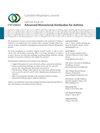中性粒细胞与淋巴细胞比值与急性呼吸窘迫综合征患者有创机械通气的需求和持续时间相关:一项回顾性研究
IF 2.1
4区 医学
Q3 RESPIRATORY SYSTEM
Canadian respiratory journal
Pub Date : 2022-07-16
eCollection Date: 2022-01-01
DOI:10.1155/2022/1581038
引用次数: 3
摘要
背景:急性呼吸窘迫综合征(ARDS)与高住院死亡率相关,大多数ARDS患者需要呼吸机支持。根据患者的个体情况应用合适的通气策略直接影响患者的预后。中性粒细胞与淋巴细胞比率(NLR)可预测2019冠状病毒病(COVID-19)患者早期对有创机械通气(IMV)的需求。本研究旨在探讨ARDS患者基线NLR与IMV之间的关系。方法:回顾性分析2017年至2022年苏州大学第一附属医院收治的按照柏林定义诊断为ARDS的患者。从病案系统中收集ARDS诊断后24 h内的临床资料。根据住院期间的通气策略将患者分为三组,比较其临床特征。此外,采用logistic回归分析筛选IMV的独立危险因素。本文采用频闪检查表。结果:纳入520例ARDS患者,IMV组NLR中位数显著高于其他组(P < 0.001)。NLR与ARDS患者IMV需要量显著相关(OR, 1.042;95% ci, 1.025-1.060;P < 0.001),其他独立危险因素包括PaO2/FiO2、Hb、乳酸和血管活性药物的使用(均P < 0.05)。此外,我们发现高NLR患者的IMV持续时间更长(分别为8[IQR, 3-13], 10[IQR, 6-16], P=0.025)。结论:我们的研究结果显示,高基线NLR水平与ARDS患者IMV风险增加显著相关。此外,较高的NLR与ARDS患者的IMV持续时间延长有关。本文章由计算机程序翻译,如有差异,请以英文原文为准。


The Neutrophil-to-Lymphocyte Ratio is Associated with the Requirement and the Duration of Invasive Mechanical Ventilation in Acute Respiratory Distress Syndrome Patients: A Retrospective Study.
Background Acute respiratory distress syndrome (ARDS) is associated with high in-hospital mortality and most ARDS patients require ventilatory support. Applying appropriate ventilation strategies based on patients' individual situations has a direct impact upon patients' outcome. The neutrophil-to-lymphocyte ratio (NLR) has been shown to predict the early requirement of invasive mechanical ventilation (IMV) in patients with coronavirus disease 2019 (COVID-19). Our study aimed to investigate the relationship between baseline NLR and IMV in ARDS. Methods A retrospective study was performed on patients who were diagnosed with ARDS using the Berlin definition and admitted to the First Affiliated Hospital of Soochow University from 2017 to 2022. Clinical data within 24 h after the ARDS diagnosis were collected from the medical record system. Based on the ventilation strategies during hospitalization, patients were divided into three groups and their clinical characteristics were compared. Furthermore, logistic regression analysis was used to screen the independent risk factors for IMV. STROBE checklist was used for this manuscript. Results 520 ARDS patients were included and the median NLR value in IMV group was significantly higher than that of other groups (P < 0.001). NLR was significantly associated with the requirement of IMV in ARDS patients (OR, 1.042; 95% CI, 1.025–1.060; P < 0.001), other independent risk factors included PaO2/FiO2, Hb, lactate, and use of vasoactive drugs (all P < 0.05). Moreover, we found that the duration of IMV was longer in patients with high NLR (8[IQR, 3–13], 10[IQR, 6–16], respectively, P=0.025). Conclusions Our results revealed that high baseline NLR level was significantly correlated with an increased risk of IMV in patients with ARDS. Furthermore, higher NLR was associated with prolonged duration of IMV in patients with ARDS.
求助全文
通过发布文献求助,成功后即可免费获取论文全文。
去求助
来源期刊

Canadian respiratory journal
医学-呼吸系统
CiteScore
4.20
自引率
0.00%
发文量
61
审稿时长
6-12 weeks
期刊介绍:
Canadian Respiratory Journal is a peer-reviewed, Open Access journal that aims to provide a multidisciplinary forum for research in all areas of respiratory medicine. The journal publishes original research articles, review articles, and clinical studies related to asthma, allergy, COPD, non-invasive ventilation, therapeutic intervention, lung cancer, airway and lung infections, as well as any other respiratory diseases.
 求助内容:
求助内容: 应助结果提醒方式:
应助结果提醒方式:


